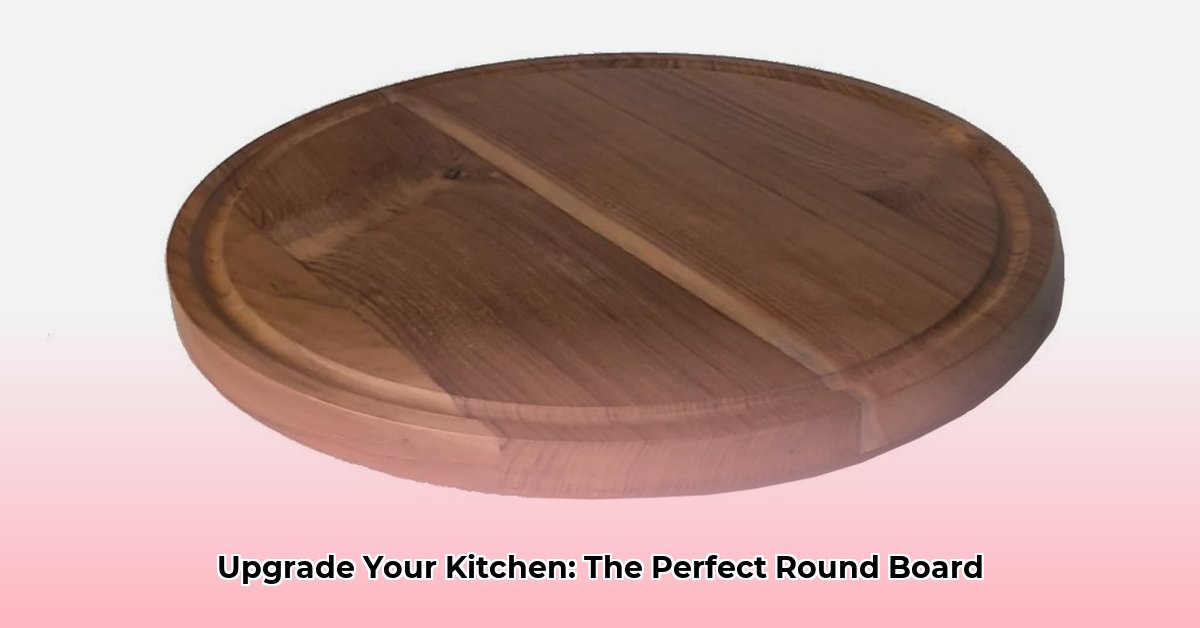Picking the perfect round cutting board can seem tricky with all the choices out there – wood, plastic, glass, even bamboo! This guide makes it easy. We’ll break down the pros and cons of each type, so you can find one that fits your cooking style and budget. Whether you’re a pro chef or just starting out, we’ll help you choose a board that’s durable, easy to clean, and won’t dull your knives. For beautiful, durable options, check out these [round charcuterie boards](https://www.wavesold.com/round-charcuterie-board/). Let’s get you the best cutting board for your kitchen!
Round Cutting Boards: Your Guide to the Perfect Kitchen Companion
Choosing a round cutting board might seem simple, but there’s more to it than meets the eye! The right one can make meal prep a breeze, while the wrong one could lead to dull knives or even food safety concerns. Let’s dive into the details to help you find your perfect kitchen companion and explore the benefits of round cutting boards. They offer a unique blend of functionality and aesthetics.
Material Matters: Considering Round Cutting Board Materials and Construction
The material you choose significantly impacts your cutting board’s lifespan, how well it protects your knives, and how easily it stays clean. Each has its pros and cons, affecting how you use your round cutting board:
- Wooden Wonders: Wood cutting boards have a classic appeal. Their natural beauty often makes them a kitchen centerpiece, and a wooden round chopping board can last for many years if properly cared for. Hardwoods like maple, walnut, or cherry are popular choices. Look for end-grain construction, where the wood fibers run vertically; this is gentler on knives and more resistant to scarring. However, wood needs regular cleaning and oiling to keep it sanitary and prevent cracking. Always hand-wash wood cutting boards and avoid soaking them in water.
- Plastic Practicality: Plastic cutting boards are budget-friendly and widely available. They’re usually dishwasher-safe, making cleaning a cinch. High-density polyethylene (HDPE) is a common and durable type of plastic used in cutting boards. However, they can dull knives over time, and deep cuts might harbor bacteria. Sanitize plastic boards regularly with a diluted bleach solution.
- Metal Marvels (Stainless Steel): Stainless steel boards are incredibly durable and easy to clean; a quick wipe-down suffices. Their non-porous surface resists bacteria, but steel is notoriously tough on knife blades, leading to dulling and potentially damage. These are best suited for tasks where knife sharpness isn’t paramount, such as kneading dough or rolling pastry.
- Glass Durability: Glass cutting boards offer similar benefits to stainless steel in terms of durability and easy cleaning. Their smooth surface is very sanitary, a major plus for food safety, but like steel, glass is incredibly hard on knives. Avoid using glass boards for chopping or slicing; they’re better suited for serving or displaying food.
- Bamboo Benefits: Bamboo cutting boards are a sustainable and eco-friendly option. Bamboo is a fast-growing grass that’s naturally antimicrobial. It’s also relatively gentle on knives and more water-resistant than wood. However, bamboo can be prone to splintering if not properly cared for. Oil bamboo boards regularly to prevent drying and cracking.
- Silicone Style: Silicone cutting boards are flexible, heat-resistant, and non-slip. They’re also gentle on knives and easy to clean. Silicone is a good option for rolling out dough or working with sticky ingredients. However, silicone boards can be more expensive than plastic or wood.
Keeping It Clean: Cleaning a Round Cutting Board and Maintaining Hygiene
No matter the material, keeping your round cutting board clean is crucial. Food safety should always be a priority. Here’s how to ensure yours stays squeaky clean:
- Wash Immediately After Use: Don’t let food residue sit; wash your board right after each use to prevent bacteria build-up.
- Hot, Soapy Water is Essential: Use warm, soapy water for a thorough clean and scrub away any stuck-on bits. A dedicated scrub brush can be helpful.
- Dishwasher Use (Sometimes): Check the manufacturer’s instructions, as many plastic and metal boards are dishwasher-safe. Avoid using the dishwasher for wood or bamboo unless otherwise specified. High heat can warp or crack these materials.
- Thorough Drying is Key: Always let your cutting board air dry completely, as moisture can lead to mold growth. Prop the board up on its side so air can circulate.
Wooden and bamboo boards need extra attention, so consider oiling them periodically to maintain their condition and prevent them from drying and cracking, using food-grade mineral oil or specialized cutting board oils. Apply the oil liberally, let it soak in for a few hours, and then wipe off any excess.
Durability and Lifespan: Maximizing Round Cutting Board Use
The lifespan of your cutting board depends largely on its material and how well you care for it. A well-maintained wooden or bamboo board might last for years, even decades. Plastic boards generally last a few years before showing excessive wear and tear with regular washing. Metal and glass boards are known for exceptional longevity; however, accidental damage is common. Scratches and chips can make them unsafe to use.
Finding the Perfect Fit: Round Cutting Boards for Every Kitchen and Budget
Choosing the perfect round cutting board is subjective; it largely depends on what matters most to you, impacting your round cutting board shopping:
- Budget-Conscious: Plastic boards generally represent the best value for money. They are inexpensive and widely available. Look for thicker plastic boards, as they tend to be more durable.
- Durability Focused: If you want a board that will last, stainless steel and glass are your go-to options. They are tough and resistant to damage. However, be mindful of their impact on your knives.
- Knife-Friendly: To keep your knife blades sharp, opt for wood, bamboo, or silicone boards. These materials have a softer surface that won’t dull your knives as quickly.
- Aesthetically Pleasing: For a statement piece that looks as good as it performs, a beautifully finished wooden board may be your best choice. Choose a wood with a rich grain pattern and a smooth, polished finish.
- Eco-Friendly: Bamboo is a sustainable and renewable resource, making it an excellent choice for environmentally conscious cooks.
Think about your cooking style. For example, those who tackle tough root vegetables often should lean towards boards of higher durability, such as wood or bamboo. If you frequently handle raw meats, consider having a separate plastic board that can be easily sanitized.
Round Cutting Board Comparison: Material Selection
| Material | Knife Friendliness | Hygiene | Heat Resistance | Durability | Cost | Special Considerations |
|---|---|---|---|---|---|---|
| Wood (End Grain) | Excellent | Medium | Medium | High | High | Requires regular oiling; choose hardwoods like maple |
| Wood (Edge Grain) | Good | Medium | Medium | Medium | Medium | More prone to knife marks than end grain |
| Plastic (HDPE) | Medium | Good | Low to Medium | Medium | Low | Dishwasher safe; can harbor bacteria in deep cuts |
| Silicone/Rubber | Good | Good | High | Medium | Low to Medium | Non-slip; good for rolling dough |
| Steel | Low | High | High | High | Medium to High | Tough on knives; best for kneading or pastry |
| Glass | Low | High | High | High | Medium to High | Very sanitary; best for serving and display |
| Bamboo | Good | Medium | Medium | Medium | Medium | Sustainable; requires regular oiling; prone to splintering |
Your ideal round cutting board is out there, waiting to be discovered! Consider what’s most important—durability, hygiene, cost, aesthetics, or knife-friendliness—and choose the one that best complements your cooking style and kitchen. Consider purchasing multiple boards for different tasks to prevent cross-contamination.
How to Choose the Best Round Cutting Board Material for Longevity and Hygiene
- The ideal round cutting board material balances hygiene, durability, and knife sharpness to enhance cooking and food preparation.
- Plastic boards are easy to clean and sanitize but can dull knives over time, impacting user experience.
- Wooden and bamboo boards are gentler on knives but require more diligent care, adding maintenance considerations.
The best choice depends on balancing these factors to meet specific needs.
Understanding Your Needs: Evaluating Round Cutting Board Material and Size
Before diving into materials, let’s consider your cooking habits. Are you a casual home cook or a culinary enthusiast? Do you frequently handle raw meats? Your answers will influence your material choice, making round cutting board use more efficient. For example, a professional chef might need multiple boards – one for meats, one for vegetables, and one for general prep. Consider the size of your countertop and storage space when choosing a board size.
Material Showdown: Plastic vs. Wood vs. Bamboo
Let’s compare the most popular materials for round cutting boards.
Plastic: Plastic boards are a popular choice due to their affordability and ease of cleaning. Many are dishwasher-safe, making sanitation a breeze. However, they can dull knives and may not
- Modern Kitchen Backsplash Ideas To Inspire Your Refresh - December 19, 2025
- Modern Backsplash Ideas: A Guide to Todays Kitchen Trends - December 18, 2025
- Ceramic Kitchen Wall Tiles: Style and Protection for Your Walls - December 17, 2025









